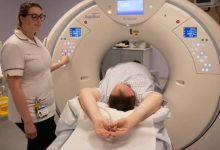
Obstetrics and gynecology are frequently used interchangeably. Gynecology is the study and care of female health, including the female reproductive system, while obstetrics (OB) is the care and study of delivery and the care of women giving birth. Although the majority of gynecologists also do obstetrics, some gynecologists choose to focus purely on gynecology. The average salary for obstetrics and gynecology (OB/GYN) physicians is $175,000, while Indeed periodically updates compensation averages for obstetrics and gynecologists. Geographical location and experience are the two most important criteria in determining compensation.
Salary of a Gynaecologist in the United Kingdom
Gynaecologists earn an average of £74,300 gross per year (£4,300 net per month), which is £44,700 (+151%) more than the national average pay in the UK.
The average starting salary for a Gynaecologist is £36,800. The top incomes might reach £200,000,000.
A Gynaecologist with less than three years of experience can expect to earn £36,800 in gross annual remuneration. An experienced Gynaecologist with 10-20 years of experience earns on average £124,300, whereas a mid-career Gynaecologist with 4-9 years of experience earns on average £72,900. Gynecologists with more than 20 years of experience can expect to earn an average of £161,200.
Job Outlook for Gynecologists
Gynecologists have a promising future. According to the Bureau of Labor Statistics, the job outlook for all physicians is expanding at a pace of 7%, which is greater than the national average for all jobs. Between 2018 and 2028, over 55,000 new jobs are predicted to be generated. This could be attributed to rising healthcare demand in general, as well as an aging population and a huge generation approaching childbearing years.
Related Post:Aeronautical engineering salary
Gynecologists are in high demand in both urban and rural locations, and there are sometimes financial incentives for GYNs to relocate to those underserved areas. Becoming a gynecologist necessitates a significant time commitment. Even as a practicing physician, you must keep up with continuing education obligations and technological changes.
How to become a Gynecologist
The requirements for admission to medical schools differ from one school to the next and are quite tough. The majority of applicants, however, are required to provide transcripts, MCAT scores, and letters of recommendation.
Apparently, if you want to pursue an undergraduate degree, you should consider studying biology and chemistry classes, which are the fundamentals of medicine and health science education.
Students must spend the first two years of medical school in laboratories and classrooms, taking subjects like biochemistry, microbiology, pharmacology, and psychology, according to the regulations controlling medicine and health.
They also learn how to take medical histories, identify ailments, and examine patients in a realistic setting.
School of Medicine
Medical students are working with patients in hospitals under the supervision of experienced doctors at this stage. Students are introduced to obstetrics, gynecology, and surgery, and they gain valuable experience in a variety of medical fields.
They also learn about women’s health issues, such as sickness diagnosis, management, prevention, and treatment.
In addition, students have access to a variety of medical equipment and tools that allow them to practice OBGYN through clinical rotations.
Students must pass the Board of Obstetrics and Gynecology exam to receive certification after completing all of the courses. To keep the certificate, the exam is repeated every six years.
Related Post:Nuclear engineer salary: University Admission and Job Outlook
Internship
Following medical school, an internship and residency in a hospital are required. Internship is a crucial stage in establishing a successful career.
Medical graduates, on the other hand, must work for one year in a recognized hospital before receiving full registration.
Furthermore, an internship normally lasts one year, whereas a medical residency lasts three to seven years. Obstetrics and gynecology residents are compensated to examine patients, provide treatment plans, and follow up with patients during their residency.
Licensure
The final step is to get a license. Obtaining a license can be a difficult procedure. A medical license, on the other hand, allows you to legally practice medicine.
To be granted a license, you must pass a test administered by the United States Medical Licensing Examination (USMLE), which assesses your ability to apply medical concepts and principles to your practice. A license is required to practice as an OBGYN.
Universities offering Gynecology Programs.
Medical School at the University of California
The deadline to apply to the University of California-San Francisco School of Medicine is Oct. 15. The University of California-San Francisco charges an application fee of $80. Full-time tuition is $36,342 (in-state) and full-time tuition is $48,587. (out-of-state). At the University of California-San Francisco, the faculty-to-student ratio is 4:1. There are 2,624 full-time faculty members in the School of Medicine.
Medical School at Harvard University
The Harvard Medical School has a deadline of Oct. 22 for applications. Harvard University charges a $100 application fee. Its full-time tuition is $64,984. Harvard University has a faculty-to-student ratio of 14.2:1. There are 9,954 full-time faculty members at the Medical School.
Since its founding in 1782, Harvard Medical School has continued to innovate and influence medical education. Students are now organized into five academic societies, each of which provides mentoring and advising as well as the opportunity for team-based learning under faculty supervision. The Harvard-MIT Health Sciences and Technology program is open to students interested in pursuing a career in biomedical research.
Following the annual White Coat Ceremony for the incoming class, most HMS students enroll in the Pathways program, which allows them to learn key scientific topics and develop clinical abilities before commencing their major clinical experiences in the second year. There are no typical letter grades in preclerkship courses; instead, pupils are given a good or unsatisfactory grade. Students attend classes at the medical school’s Longwood Medical Area location and can do clinicals at associated institutions throughout Boston. Medical students can also pursue dual degrees such as an M.D./Ph.D. or an M.D./MBA, as well as cross-register in courses at the university’s other schools, such as the highly renowned Law School and Business School.
Despite the rigorous course load, HMS ensures that its students have a good time by hosting events and social groups such as the HMS Chamber Music Society, as well as a number of extracurricular organizations focused on service, identity, and other topics.
Medical School at Northwestern University
The Feinberg School of Medicine at Northwestern University (Feinberg) has a deadline of November 1 for applications. Northwestern University (Feinberg) charges a $95. application fee. Its full-time tuition is $64,262. At Northwestern University (Feinberg), the faculty-to-student ratio is 2.9:1. There are 1,888 full-time faculty members at the Feinberg School of Medicine.
Letter grades are never given to students at Chicago’s Northwestern University Feinberg School of Medicine. Instead, first- and second-year students receive pass/fail marks, while third- and fourth-year students earn honors, high pass, pass, and fail ratings. Optional activities are scheduled for three afternoons every week. The Feinberg School of Medicine also offers a number of graduate research programs, including an M.D./M.M. program that allows students to earn both a doctorate in medicine and a master’s degree in management from the Kellogg Graduate School of Management in five years, as well as a 27-month physical therapy program.
Related Post:Corporate Counsel Salary: Job Requirements and Career
From the Musicians in Music club, which plays in local hospitals and healthcare centers, to Jugulars, the school’s official juggling club, Feinberg students can join more than 50 organizations. Students can reside on or off campus at the School of Medicine, which is located in the Chicago neighborhood of Streeterville. (More than 70% of students opt for off-campus living.)
Charles Mayo, the founder of the Mayo Clinic, and Debi Thomas, an orthopedic surgeon who won a bronze medal in figure skating at the 1988 Olympics, are both Feinberg School of Medicine graduates.
Medical School at Johns Hopkins University
The application deadline for Johns Hopkins University’s School of Medicine is Oct. 15. Johns Hopkins University charges a $100 application fee. Its full-time tuition is $56,500. At Johns Hopkins University, the faculty-to-student ratio is 5:1. There are 2,397 full-time faculty members in the School of Medicine.
The Genes to Society Curriculum, which combines academics with clinical experience, is used by students at Johns Hopkins University School of Medicine. Intersessions, which are weeklong special courses focused on simulation and advanced abilities, occur every few months. Nathans, Sabin, Taussig, or Thomas are the colleges to which all students are assigned. This is intended to develop a sense of belonging among students from all four years of medical school. Advisers are assigned to each college to help students through medical school coursework, research participation, and career choices. The colleges hold a Colleges Bowl every year, which includes kickball, racing, and tug-of-war sports.
In around eight years, students can achieve a standard M.D., a Ph.D., or both. Other university departments offer dual degree programs for an M.D./Master of Public Health and an M.D./MBA. The school receives significant research support from the National Institutes of Health and other organizations, and it houses prestigious research institutes such as the Brain Science Institute and the Institute of Genetic Medicine.
The highly regarded Johns Hopkins Hospital, which is especially well-known for housing Maryland’s sole pediatric and ocular trauma clinics, is part of Johns Hopkins Medicine. Students can live on campus in an apartment building two blocks away from the medical campus in Baltimore. Students can join over 80 different organizations, some of which organize community service projects all across Baltimore.








